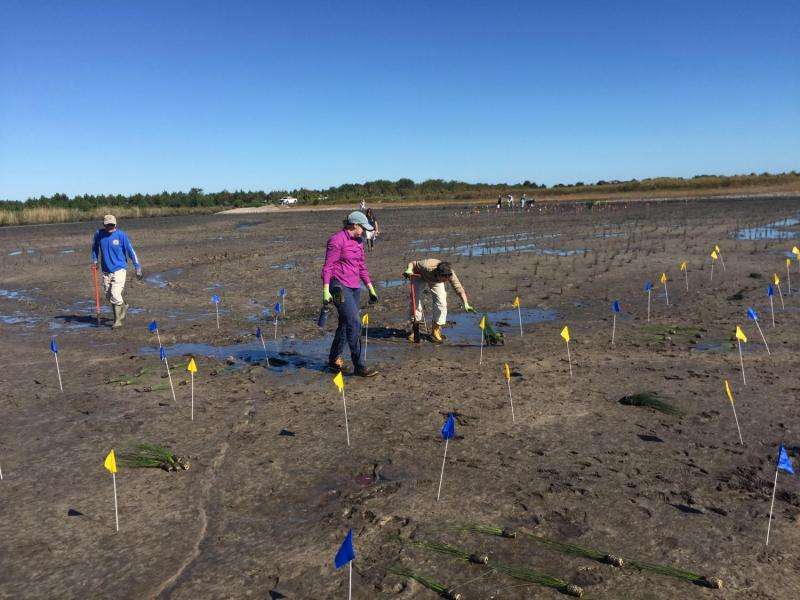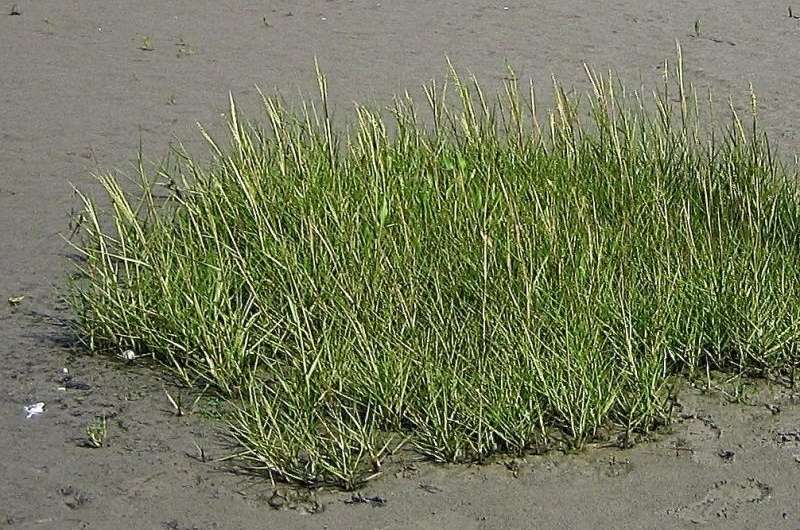A team of researchers planting a restored wetland test site in Florida. Credit: Credit: Brian Silliman, Duke Univ.
When restoring coastal wetlands, it's long been common practice to leave space between new plants to prevent overcrowding and reduce competition for nutrients and sunlight
It turns out, that's likely all wrong.
A new Duke University-led study, conducted to restore degraded salt marshes in Florida and the Netherlands, has found that clumping newly planted marsh grasses next to each other, with little or no space in between, can spur positive interactions between the plants and boost growth and survival by 107 percent, on average, by the end of one growing season.
In some test plots, plant density and vegetative cover increased by as much as 300 percent by season's end.
"This is a really small design change that can yield greatly improved results, without adding to restoration costs or time," said Brian R. Silliman, Rachel Carson Associate Professor of Marine Conservation Biology at Duke. "It's essentially free success—higher yields at no added expense."
Silliman and his colleagues published the new peer-reviewed research today (Nov. 2) in the Proceedings of the National Academy of Sciences.
Their finding, which is applicable to a wide array of coastal restoration efforts worldwide, upends a 40-year-old theory borrowed from forestry that new plants—called outplants by restoration ecologists—need to be spaced well apart from each other to reduce competition and generate the highest growth rates.
Marsh grasses planted in a clump (foreground) exhibit greater density and growth after one season than grasses planted well apart in spaced rows (background). Credit: Brian Silliman, Duke University
"In a low-stress field or forest, that makes sense. But in the tough, volatile environment of re-developing coastal wetlands, it's a different story," Silliman said.
Like an overprotected child, a plant that is spaced too far from other plants and species in a restored wetland will experience not only fewer negative interactions but also fewer positive ones, which often outweigh the negatives, Silliman said. Left to fend on their own, small outplants will have more trouble resisting erosion, overcoming low oxygen levels in the soil, or surviving infestations and overgrazing by marsh herbivores, among other common threats.
"The bottom-line message is: A coastal wetland plant that is planted close to its neighbors will grow better than a plant that isn't," Silliman said. "Our findings clearly demonstrate that planting closely does not spur negative competition; on the contrary, it allows positive interactions to flourish, so plants can work together to survive."
Convincing others to adopt this new approach may be a challenge. A survey conducted by Silliman and his team as part of their new study found that 95 percent of restoration organizations in the United States still adhere to the old forestry-based practice of dispersed planting. The old practice remains common in other countries, as well.
"In China, where coastal marshes have experienced massive die-offs recently from drought and overgrazing, people have tried unsuccessfully to restore them using the old paradigm that spaces out plants," said Qiang He, a postdoctoral associated in Silliman's lab. "It's possible that changing planting designs could greatly improve the success of salt marsh restoration there, as clumping could protect plants from salt stress and overgrazing."
"In the very near future, conservation will entail immense restoration projects on the scale of whole ecosystems, islands or cities. We won't just be restoring them - we'll be augmenting existing ecosystems and creating new ones to provide the services we need," Silliman said. "Increasing our yields and decreasing our costs to achieve these goals must be a high scientific priority. This study takes a big step in the right direction by showing how harnessing positive interactions can increase restoration success."
More information: "Facilitation Shifts Paradigms and Can Amplify Coastal Restoration Efforts," Brian R. Silliman, Elizabeth C. Schrack, Qiang He, Rebecca Cope, Amanda Santoni, T. van der Heide, Ralph Jacobi, Mike Jacobi, Johan van de Koppel; Nov. 2, 2015, Proceedings of the National Academy of Sciences; DOI: 10.1073/pnas.1515297112
Journal information: Proceedings of the National Academy of Sciences
Provided by Duke University





















